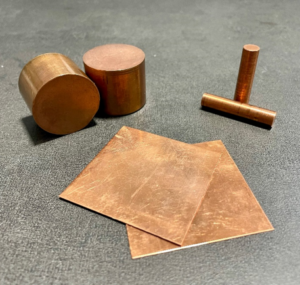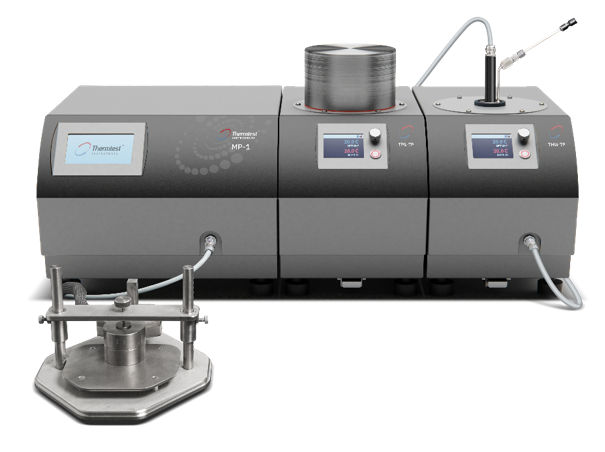Copper is an extremely versatile and abundant element that is used in all kinds of different applications. It is an efficient conductor of heat and electricity, as well as a ductile, malleable material. Although copper does oxidize or react with oxygen when exposed to water and air for long periods of time, it does not rust like many other metals. Therefore, copper is an essential component in a variety of industrial and technological applications today.
Understanding the thermal conductivity of a material is essential in many different applications. There are different methods to test the thermal conductivity of copper. In this application, we will be exploring the different modifications of the Transient Plane Source (TPS) method for measuring samples of copper of different shapes and sizes.
Three samples of copper of different shapes and sizes were measured for thermal conductivity (W/m·K), thermal diffusivity (mm2/s), and volumetric specific heat (MJ/m3K) using MP-1 Transient Plane Source (TPS) Method. There is a selection of testing modules under the TPS method that are grouped based on their testing theory. In this application, we will be using a variety of testing modules: Standard, Slab, and One-dimensional, to accommodate the different samples of copper.
Copper is a naturally occurring metallic element. This malleable metal can come in a variety of different alloys and compositions. It is a soft metal, meaning pure coper is too soft to serve some applications. It was discovered that copper could be hardened with other metals such as tin for form the alloy, bronze. The excellent alloying properties of copper have increased its usability when combined with other metals. These alloys have specialized characterized, and the different compositions allow them to be used for different applications. Copper and copper alloys are essential for many different industries such as architecture, automotive, electrical, plumbing, and industrial.

Figure 1. Three samples of copper.
The MP-1 is designed to test the absolute thermal conductivity (W/m·K), thermal diffusivity (mm2/s) and specific heat (MJ/m3K) of solids, liquids, pastes and powders with the powerful combination of the transient plane source (TPS, ISO 22007-2) and transient hot-wire (THW, ASTM D7896-19) methods.
The MP-1 with TPS Standard Module is used to measure the average or bulk thermal conductivity and thermal diffusivity of isotropic materials. The MP-1 TPS Slab module is used to measure the thermal conductivity of thin sheet materials with moderate to high thermal conductivity (up to 1800 W/m·K) and of uniform thickness (< 8 mm). The MP-1 TPS One-dimensional module is used to accurately measure the thermal conductivity along the length (or “height”) of a solid sample in the form of cylinders or blocks up to 1800 W/m·K. Measurements can be made symmetric or asymmetric. The module is selected based on the sample properties and dimensions.

Figure 2. MP-1 with THW-TP and TPS-TP.
To measure the thermal conductivity of copper using the transient plane source method, two samples of copper are placed on top of one another (symmetric configuration) with the TPS sensor sandwiched in the middle. This TPS sensor acts both as a heat source for increasing the temperature of the sample and a “resistance thermometer” for recording the time dependent temperature increase. The intelligent Transient Plane Source (iTransient) application was used to determine optimal measurement parameters for each sample of copper to achieve optimal temperature rise and thermophysical property measurements.
Standard TPS measurements are done when the radius of the sample is at least twice as large as the radius of the TPS sensor. One-dimensional TPS measurements are done when the samples have roughly the same radius as the TPS sensor. This module assumes that the heat flows only in one dimension. When performing a TPS slab measurement, an insulator is placed above the top sample and below the bottom sample. This enforces the boundary condition such that there is no heat transfer to the upper and lower edges of both samples.
Table 1. Thermal conductivity (W/m·K) of three copper samples, measured with the Standard Bulk, Slab, and One-Dimensional modifiers.
| Method | Thermal Conductivity (W/m·K) |
| Standard Bulk | 396.3 |
| Slab | 403.5 |
| One-Dimensional | 398.6 |
Measuring the thermal conductivity of samples of different compositions and dimensions can be challenging. The TPS modifiers such as Standard, Slab, and One-Dimensional allow for the different types of samples to be measured efficiently and accurately.